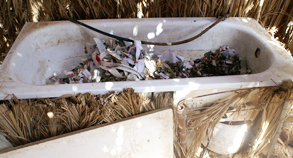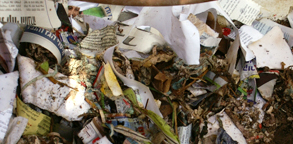 |
|
VermicompostingFeed your leftovers to worms and they will give you in return, fresh soil!  Vermicomposting is the art of using worms Specifically (E. foetida) to break down organic waste - usually primarily food scraps from your plate and kitchen. Why might you choose to use the vermicompost method?There are a few general reasons:
 A happy worm population will make great, fast, nice-smelling compost. In order to get the most out of your worm compost, you need to understand what a worm needs to be happy. FoodWorms are structured as a “tube within a tube,” with a long, linear digestive tract running from their mouth at the front end of their bodies to their anus at the very back. Most of it is simply an intestine for absorbing nutrients. Because a worm’s skin is translucent, it is possible to see particles of food moving through the worm’s body. Worms have no teeth. The mechanical digestion works by squeezing the food through the digestive tract along with particles of grit. When the food matter passes out of the worm’s body, it is called “worm castings.” Unlike earthworms these worms eat organic matter and so are perfect for digesting your food scraps. Gas ExchangeWorms exchange gas directly through the thin, moist membrane of their skin. In order for a worm to breathe, their skin must remain moist and in contact with air. Too much liquid or not enough fresh air in a compost bin can kill worms drainage and air holes. For this same reason it is not recommended to put a lot of oil or oily foods into the worm bin. ExcretionWorms filter their blood in small organs called nephridia and “pee” out the liquid from holes in their skin called nephridiopores. It it yellow and high in nitrogen, like human pee. Worms also “pee” out a liquid from their skin when they are agitated. ReproductionWorms are hermaphrodites - each has both male and female reproductive organs. However, two different worms are necessary for each reproductive act. Egg and sperm are combined in the clitellum and form a “cocoon” egg that can have many worms inside. Senses and MovementWorms can sense light. They do not have eyes, but they do have some kind of photoreceptors. They can also sense vibrations, touch, moisture, and temperature. Worms move by bunching up the segments on one part of their body and then stretching them out, dragging themselves along the ground. The setae help create traction. Creating a Worm BinNow that you understand a bit about the worm it is time to make him/her a home and to start feeding him/her a healthy diet of food scraps. Worms are surface feeders so you will need a box that holds up well in moist conditions 12 inches or 30 centimeters deep and twice as wide. The worms need some sort of high-carbon material for their bedding. Avoid shredded straw or hay, dried grass, and other garden debris are avoided. The best choice is shredded non-glossy paper.  Newspaper is a great worm bedding material. Once you have your worm bin, line the bottom with about 3 inches or 8 centimeters of shredded paper. Add a handful of clean sand to that the worms will have some grit in their systems. Get the paper wet, but not too wet—it should have the moisture of a wrung-out sponge. This layer of paper will remain on the bottom of the box, and will eventually be digested by the worms.  The bottom layer of a worm bin. Now you are ready to introduce your worms. Make sure that before introducing them you have enough shredded paper to be able to completely cover the worms. Place the worms on top of their bedding, place a one in ch or two centimeter layer of food on top of them, and on top of that add another layer of moist bedding material.  On Lotan, we reused an old bathtub to house our worms. What and how to feed the worms.At each feeding you will need to lift away the top bedding layer and place the food underneath that top layer, in the area where the worms are. Avoid too much highly acidic food such as citrus peels, and too much oil or oily foods - both of these can interfere with the worms respiratory system. Also avoid dairy products, bread, and meat. These foods are less preferred by the worms and have a tendency to grow mold and disturb the balance of the bin. At each feeding, spread out the food into a layer that is no deeper than 1 inch or 2 centimeters. After every feeding make sure there is enough moist bedding material to fully cover the worms and their new food. How many worms do you need?Worms eat half their weight per day. If you produce one pound of waste per day you need at least two pounds of worms to eat it. If given the right conditions, worms reproduce relatively quickly and soon you will have more worms than you need and you can give some to your friends! Resources:
Contact Lotan Center for Creative Ecology |
|
|

